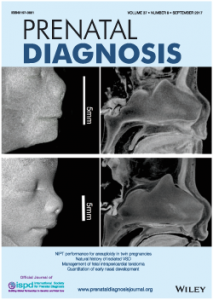共同研究者の勝部先生の論文の図がprenatal Diagの表紙に採用されました。
- 出生前初期の成長に伴う鼻中隔、 anterior nasal spine(ANS) の発達を評価
- 正中矢状画像を用いて鼻中隔の発達について幾何学的形態計測学を使用して分析
- ANS および鼻中隔の形状の成熟期間は、それぞれ12 週および 14 週前後
- 鼻中隔の前後方向の発達は、妊娠 14 週まで特異的であり、鼻の突出と ANS の発達に重要
- この時期の発達の障害は、バインダー表現型等の低鼻変形を誘発する可能性
⑭ Katsube M, Yamada S, Miyazaki R, Yamaguchi Y, Makishima H, Takakuwa T, Yamamoto A, Fujii Y, Morimoto N, Ito T, Imai H, Suzuki S, Quantitation of nasal development in the early prenatal period using geometric morphometrics and MRI: A new insight into the critical period of Binder phenotype. Prenatal Diag 37: 907–915, 2017, DOI: 10.1002/pd.5106.2017
Abstract
Objectives
Disturbance of the development of the nasal septum in the early prenatal period causes congenital facial anomalies characterized by a flat nose and defects of the anterior nasal spine (ANS), such as Binder phenotype. The present research aimed to assess the development of the nasal septum and the ANS with growth in the early prenatal period.
Methods
Magnetic resonance images were obtained from 56 specimens. Mid-sagittal images were analyzed by using geometric morphometrics for the development of the nasal septum, and angle analysis was performed for the development of the ANS. Additionally, we calculated and visualized the ontogenetic allometry of the nasal septum.
Results
Our results showed that the nasal septum changed shape in the anteroposterior direction in smaller specimens, while it maintained an almost isometric shape in larger specimens. Furthermore, mathematical evidence revealed that the maturation periods of the shapes of the ANS and the nasal septum were around 12 and 14 weeks of gestation, respectively.
Conclusion
The anteroposterior development of the nasal septum is specific until 14 weeks of gestation, and it is important for nasal protrusion and the development of the ANS. Therefore, the disturbance of such development could induce low nasal deformity, including Binder phenotype.








